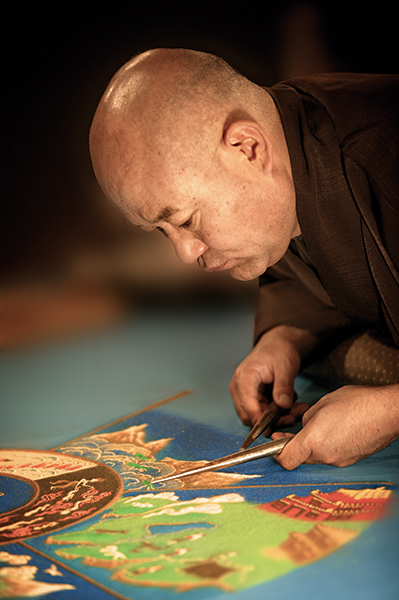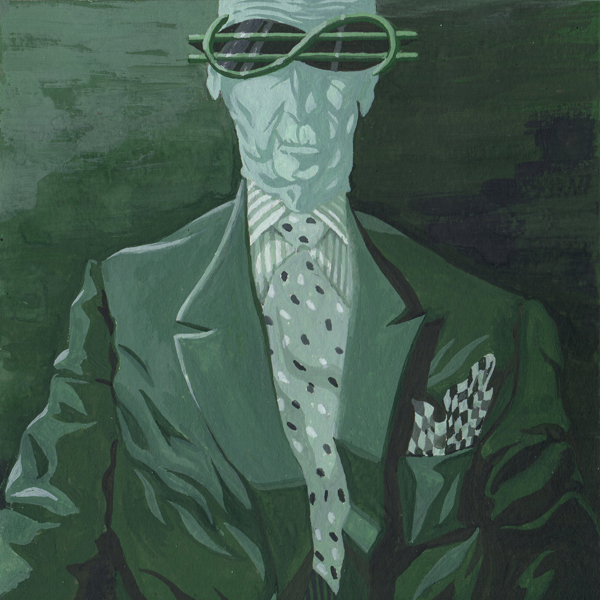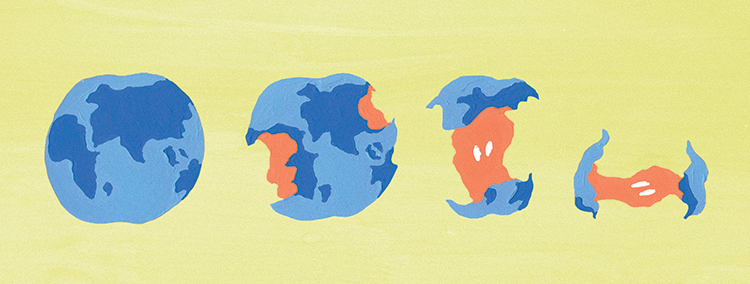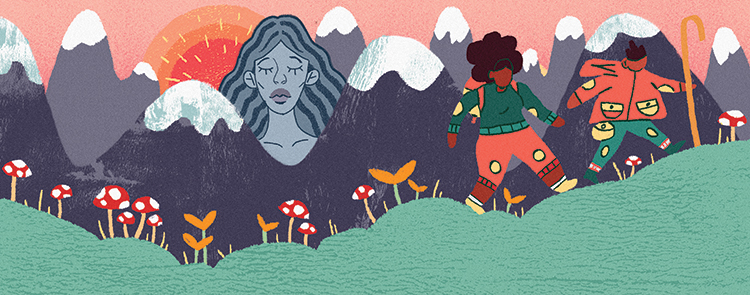Compassion Project
interview by Alex Mulcahy
Wrapped in a brown robe and exuding a disarmingly calm manner, the Tibetan-born Venerable Losang Samten does not act like someone with a looming deadline. In a small building on the campus of the Plymouth Meeting Friends Center, Samten is working on a sand mandala, quietly arranging brightly colored grains of sand into an intricate work of art. It’s a Buddhist tradition, and the mandala must be finished today because tomorrow it, like all other works of its kind, will be dismantled—a reminder of the impermanence of all that is created.
We asked Samten what, if anything, a mandala might say about sustainability, science and peace. While the piles of sand waited for his attention, Samten patiently answered our questions.
What is the purpose of a mandala?
Generally, the mandalas are a teaching tool. Mandalas are a spiritual image, a visual image for an individual to improve their concentration. There are many different reasons and purposes for a mandala. The idea is for an individual to cultivate the highest level of compassion. When you see the mandala, the benefit… it can impact a person immediately or a little further down the road of their spiritual path.
Which mandala is this?
This is the Wheel of Life. In the middle of the mandala there are three animals—a pig, a snake and a bird—and they represent ignorance, anger and greed, which is what we call the poisons. Poisons to destroy our inner peace.
Some might argue that, while a mandala is beautiful, perhaps time would be better spent directly addressing an injustice, or acting politically.
The whole idea for any meditation is to discover how to help, how to improve society, how to improve the world. To help the community, first you need to make sure you are ready for that. Before you take on the job of lifeguard, you need to know how to swim well. Otherwise you might die, too. First you need to help yourself, then you can help others. So the meditators are in the cave, or in the home, but the fundamental aim is that the person comes out of the meditation and meditates with the community, and then helps.
Anger, one of the three poisons, can motivate people to act. And it’s certainly difficult not to respond with anger when you feel that people are profiting from exploiting others, or the planet. How as a Buddhist do you handle that anger, or change it, without losing motivation to effect change?
The traditional Buddhist answer will be: Without anger, you have to fight. Without anger, you have to deal with the situation. Because when we get angry, we lose the balance. Without anger, we can save everyone. Anger is very much a part of our life. But the good side of the Buddhist view is that anger is there temporarily, not permanently. If we meditate and research, we can eliminate the anger.
An example to me is His Holiness the Dalai Lama. The Dalai Lama does not get angry with the Chinese leadership, and he is doing his best to get more human rights in Tibet. Change always takes time. Positive change takes a long time. We should not give up.
Many are skeptical of religion, and much more comfortable with science. Can the two work together?
Absolutely. In the Buddhist tradition, faith is of secondary importance. Reason is important. Logic is important. There are numerous conferences with His Holiness the Dalai Lama, Buddhist leaders and scientists, that discuss many issues—including the environment and mental sciences. The Mind and Life conference has been going for 30 years. That is such a great legacy of the Dalai Lama.
Scientists can tell us what we see, more than ever, in the 21st century, but when it comes to our internal mind and thoughts, science is still very new. His Holiness the Dalai Lama encourages the holy masters in India in monasteries to have technology be part of their conversations. So they study a lot about modern science. We are searching for what the truth is.
Is religion a hope for the environmental movement?
Education is the key factor. Me, as one member of the world, to share this mandala, it’s not to promote religion or what I believe, but as education. How do we live more peacefully? When a person is educated, there is a chance to work for change. Some people do not see the problem of the environment changing until the issue comes to their backyard. Until then, the environment issue in the U.S. is treated as a political issue instead of a fact.
What can a religious leader do to help make change?
People have difficulty with religious leaders who are saying something, but are living a different life. They should live as Buddha taught or Jesus taught. When last September the pope came, he drove a small car around town. For me, that was great symbolism. It’s a reminder to us to live in simplicity.
The Venerable Losang Samten is the spiritual leader of Chenrezig Tibetan Buddhist Center of Philadelphia, and the author of “Ancient Teachings in Modern Times: Buddhism in the 21st Century.”








